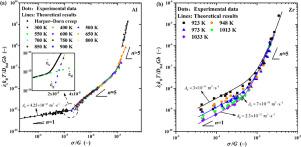International Journal of Plasticity ( IF 9.4 ) Pub Date : 2022-07-29 , DOI: 10.1016/j.ijplas.2022.103394 Xiazi Xiao , Shilin Li , Long Yu

|
In this work, a mechanistic steady-state creep model is proposed for pure metallic materials to characterize the evolution of macroscopic creep strain rate as a function of the testing temperature and applied stress. Dislocation-dominated and diffusion-dominated creep are both addressed in the developed creep model, which is able to effectively characterize the phenomena of “first-power-law” creep, “five-power-law” creep and “power-law-breakdown” creep. Thereinto, the dislocation-dominated creep behavior is systematically analyzed by considering the evolution of dislocations, which includes dislocation multiplication, strain-rate dependent dynamic recovery and time-related static recovery. Main attentions are focused on the description of dislocation static recovery that covers the annihilation of dislocations induced by the creep mechanisms of dislocation climb and thermally related dislocation glide during the long term plastic deformation. A novel form of the dislocation mobility is deduced that not only considers the effect of dislocation climb and glide, but also takes into account the contribution of mechanical work on atomic diffusion. Moreover, the latter is noticed to be the dominant reason resulting in the transition from “five-power-law” creep to “power-law-breakdown” creep. In order to verify the developed model, creep data of six metallic materials with different crystalline structures is considered to compare with the theoretical results. Good agreement is achieved for all these data over a wide range of temperature and stress, which indicates that the model can well characterize the deformation behavior during the steady-state creep stage. In addition, the contribution of dislocation multiplication, dynamic recovery and static recovery to the evolution of dislocation density is further discussed at different temperatures and stresses, which can facilitate the comprehension of the fundamental creep mechanisms of metallic materials.
中文翻译:

包含纯金属材料的位错静态恢复的一般稳态蠕变模型
在这项工作中,提出了一种纯金属材料的机械稳态蠕变模型,以表征作为测试温度和施加应力函数的宏观蠕变应变率的演变。所开发的蠕变模型同时解决了位错主导和扩散主导的蠕变问题,能够有效表征“一次幂律”蠕变、“五幂律”蠕变和“幂律击穿”现象” 蠕动。其中,通过考虑位错的演化,系统地分析了位错主导的蠕变行为,包括位错倍增、应变率相关的动态恢复和时间相关的静态恢复。主要关注点集中在位错静态恢复的描述上,它涵盖了位错在长期塑性变形过程中由位错爬升和热相关位错滑移的蠕变机制引起的位错湮灭。推导出了一种新的位错迁移率形式,它不仅考虑了位错爬升和滑移的影响,而且还考虑了机械功对原子扩散的贡献。此外,后者被认为是导致“五次幂律”蠕变转变为“幂律崩溃”蠕变的主要原因。为了验证所建立的模型,考虑了六种具有不同晶体结构的金属材料的蠕变数据,并与理论结果进行了比较。在很宽的温度和应力范围内,所有这些数据都取得了良好的一致性,这表明该模型可以很好地表征稳态蠕变阶段的变形行为。此外,进一步讨论了在不同温度和应力下位错增殖、动态恢复和静态恢复对位错密度演变的贡献,有助于理解金属材料的基本蠕变机制。











































 京公网安备 11010802027423号
京公网安备 11010802027423号